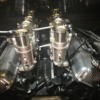Some sorry history on Pantera instrumentation: some 2 million Ford cars & light trucks used 351C engines with the water temp sender in the block. No one understands why Ford/DeTomaso added a temp sensor port in the expansion tank, except to purposely lower the gauge reading.
There are also two Ford/DeTomaso TSBs denoting two different low-wattage resistors to be spliced into the Pantera sensor wire- again, to deliberately lower the gauge reading. On my '72 L, the 'factory' resistor wasn't even soldered- only twisted into the cut sensor wire. So, sloppy connections came loose and the gauge stopped working. All this is because -A- the Italian Veglia gauge was supposed to somehow work with a mismatched U.S-made Ford temp sender.
And -B- the temp range displayed (0-220F) was too low in any case for the Pantera's normal working engine temp of about 200F. This nearly pegged the 0-220F gauge and panicked non-motorhead owners. This finally got fixed sometime in 1973 with a 0-260F gauge- which still may not read accurately but at least didn't peg the new gauge.
Bottom line: the typical 0-220F water temp gauge never did read true engine water temperature. If the car is not spitting coolant overboard, the engine is NOT overheating no matter what the dash gauge says. If you''d like, you can calibrate either gauge for good accuracy with a variable resistor tuned in that wire.
B- The Pantera sender is a 1-wire type. It is designed to ground thru the engine block. More than maybe 2 full turns of teflon plumbers tape seals coolant while electrically insulating some senders and you'll get no current to the gauge no mater what you do. ONE full wrap of teflon tape seals the low coolant pressure nicely & lets the sender ground normally. Some owners found the ungrounded sender but never made the connection about too much teflon tape. They fixed their cars by soldering a new ground wire to the sender body. Try grounding the inop' sender with a jumper; if it works, there's too much tape.
C- By NOT using TWO hex-nuts on the sender to retain the gauge wire, you run the risk of pulling the threaded stud (that makes electrical contact inside the sender), away from the internal sender element. What was supposed to happen was, a first nut is hand-threaded on the sender stud. Then the sender wire's ring-connector goes on and a second nut is installed. To tighten, the two nuts are torqued against each other, NOT against the plastic sender body. If your sender stud can be wiggled and seems loose, this is what happened.Needless to say, there will be no accuracy from a loose-stud sender no matter if the gauge needle moves. I've also found Panteras with inop' gauges; inspection showed the sender stud missing- pulled completely out of the sender body.
Your last problem is getting the 1/8-pipe plug out of the engine block. Ford practice at the time was to slam that little plug into a smoking-hot block. When things cooled off, the plug was really in there! Often, the square drive end twists off if you try removing it when stone cold. Try heating just the plug end with a torch, then shock-cool it with a candle held against the plug until the wax no longer melts. The plug now may nearly come out with your fingers. Putting the sender in the water pump has caused accuracy problems at higher engine speeds due to cavitation inside the pump- right about where the temp sensor sits.
Good luck and be patient- the thing is Italian!


